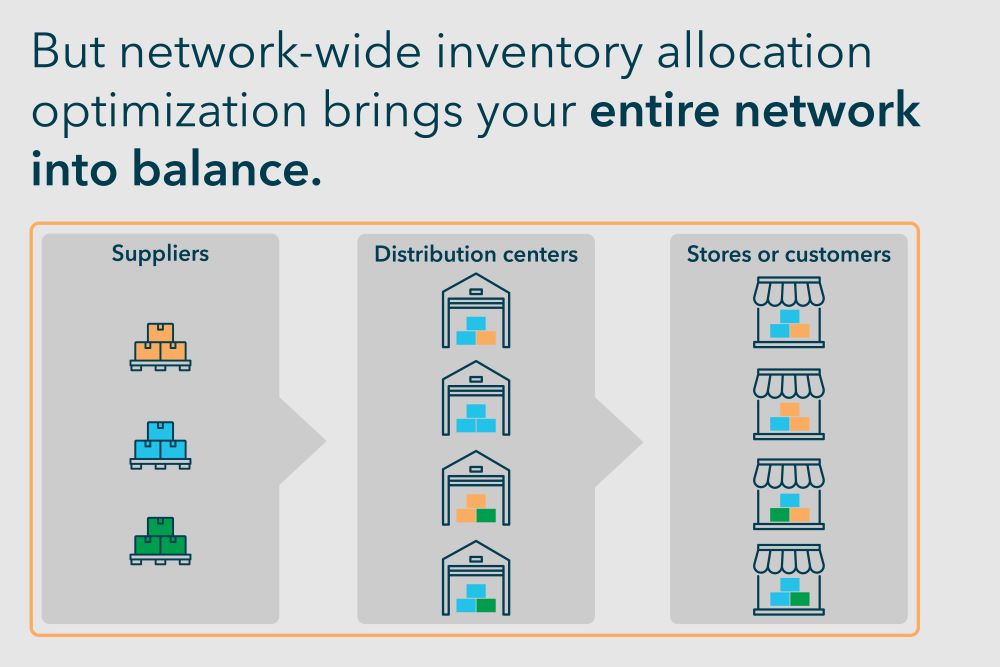Inventory costs directly contribute to product costs, making them a primary focus for supply chain professionals looking to reduce expenses in their distribution networks. In 4flow's global projects, we’ve found that inventory cost savings of 10% to 25% can be achieved by reducing overstocks and stockouts.
However, determining optimal inventory levels can be challenging. While reducing inventory can improve short-term cash flow, it may compromise supply chain performance and jeopardize customer service levels. This dilemma is particularly relevant for businesses managing physical goods in complex networks, especially those facing variable demand. Typically, these businesses include:

Author
Andreas Martin
Director Software Quality & Support
4flow software
For such organizations, traditional inventory optimization might not suffice. To address their unique challenge, a network-wide approach is often required.
Let’s explore how network-wide inventory allocation optimization achieves this balance, beginning with common challenges in inventory management when demand is fluctuating.
Challenges of managing variable demand
Uncertainty in demand forecasting
Fluctuating demand makes it challenging to accurately predict future demand levels. This uncertainty can lead to inventory shortages or excess inventory, impacting customer service levels and operational efficiency.
Stockouts and overstocking
Maintaining excess inventory during low-demand periods results in higher holding costs. Conversely, insufficient inventory during high-demand periods may lead to lost sales and missed revenue opportunities.
Service level strategy vs. cost
Different customer preferences, behaviors and policies might require an adaptable service level strategy – and create different cost levels.
Seasonal inventory management
Businesses with seasonal demand fluctuations must effectively manage seasonal inventory. This includes planning for inventory buildup before peak seasons and managing inventory liquidation strategies post-season to avoid excess stock.
Cost of expedited shipments
When facing fluctuating demand, businesses may choose to hold less inventory and rely on expedited shipping to fulfill customer orders on time. The cost of expedited shipments can significantly impact profitability.
Optimal inventory allocation – an effective approach for a complex network
Inventory optimization focusing on individual locations might be familiar to many supply chain professionals. However, when it comes to the entire network, the approach needs to be more sophisticated to optimize inventory levels based on the interdependencies between different locations. This is where optimal inventory allocation comes in.
Inventory allocation is a systematic method of distributing inventory across various channels to optimize the fulfillment of customer orders. This strategic approach involves placing stock in warehouses, distribution centers or retail outlets across the network based on anticipated demand. By carefully allocating inventory, businesses can minimize storage and carrying costs while ensuring that products are readily available when customers place orders.
This process is crucial for businesses with complex networks as it enables them to:
Imagine inventory optimization as optimizing the schedule and traffic for each station in a subway system individually.
Optimizing inventory allocation would be like managing a subway system as a whole, so each station's schedule and traffic are optimized considering the overall network.
Sound interesting?
First steps: actionable tips to start optimizing inventory allocation
Start with an accurate demand forecast that draws on historical sales data, market trends and customer insights.
Foster collaboration and communication between different departments involved in inventory management, such as sales, operations, and finance.
Implementing inventory allocation optimization requires broad expertise. Determine if your organization has the necessary analytical capabilities to forecast demand, identify trends, patterns and opportunities for each product group. You’ll also need to align a strategy across the business, define performance metrics, optimize inventory policies, collaborate across functions, and manage change effectively. Dedicate an expert team or bring in external expertise to support the process.
Consider dedicated software support designed to optimize inventory allocation and let your team concentrate on decision-making. Look for software that enables visibility, simulation and optimization.
Conduct regular inventory audits to identify discrepancies, reduce shrinkage and improve allocation accuracy. This helps businesses maintain optimal stock levels and avoid overstock or stockouts.
Optimizing inventory allocation is an effective process that reflects the requirements of complex supply chains managing products with fluctuating demand. A network-wide approach enables businesses to distribute inventory efficiently and cost-effectively across warehouses, distribution centers and other sites – while meeting target service levels and ultimately enhancing customer satisfaction.
Interested in more details? Learn more about this approach in our executive guide.
Explore software for inventory allocation optimization
The 4flow VIA® suite includes a module specifically designed for inventory allocation optimization.



